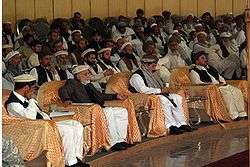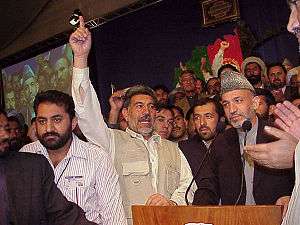Pashtunwali
Pashtunwali (Pashto: پښتونوالی ; Urdu: پختونالی) means the traditional lifestyle of the Pashtun people, also called the Pathan people.[1] Its meaning may also be interpreted as "the way of the Pashtuns" or "the code of life".[2] Pashtunwali is widely practiced among Pashtuns,[3] especially among the non-urbanized Pashtuns in the countryside, and dates back to ancient pre-Islamic times.[4] Pashtuns are the plurality ethnic group in Afghanistan. In addition to being practiced by members of the Pashtun diaspora, it has been adopted by Afghans throughout the country and Pakistanis who live in the Pashtun regions or close to the Pashtuns, who have gradually become Pashtunized over time.
| Part of a series on |
| Pashtuns |
|---|
| Kingdoms |
Overview
The native Pashtun tribes, often described as fiercely independent people,[5] have inhabited the Pashtunistan region (eastern Afghanistan and north western Pakistan) since at least the 1st millennium BC.[6][7][8] During that period, much of their mountainous territory has remained outside government rule or control. This is perhaps the main reason why indigenous Pashtuns still follow Pashtunwali, which is a basic common law of the land or "code of life".
Pashtunwali rules are accepted in Afghanistan and Pakistan (mainly in and around the Pashtunistan region), and also in some Pashtun communities around the world. Some non-Pashtun Afghans and others have also adopted its ideology or practices for their own benefit. Conversely, many urbanized Pashtuns tend to ignore the rules of Pashtunwali. Passed on from generation to generation, Pashtunwali guides both individual and communal conduct. Practiced by the majority of Pashtuns, it helps to promote Pashtunization.[2]
Ideal Pukhtun behaviour approximates the features Pukhtunwali, the code of the Pukhtuns, which includes the following traditional features: courage (tora), revenge (badal), hospitality (melmestia), generosity to a defeated...[9]
— Maliha Zulfacar, 1999
Pashtuns embrace an ancient traditional, spiritual, and communal identity tied to a set of moral codes and rules of behaviour, as well as to a record of history spanning some seventeen hundred years.[10]
Pashtunwali promotes self-respect, independence, justice, hospitality, love, forgiveness, revenge and tolerance toward all (especially to strangers or guests).[11] It is considered to be the personal responsibility of every Pashtun to discover and rediscover Pashtunwali's essence and meaning.
It is the way of the Pathans. We have melmestia, being a good host, nanawatai, giving asylum, and badal, vengeance. Pashtuns live by these things.[12]
— Abdur, A character in Morgen's War
- The Pathan tribes are always engaged in private or public war. Every man is a warrior, a politician and a theologian. Every large house is a real feudal fortress. ... Every family cultivates its vendetta; every clan, its feud. ... Nothing is ever forgotten and very few debts are left unpaid.
- Winston Churchill (My Early Life, Chapter 11: "The Mahmund Valley")
- The Pathan tribes are always engaged in private or public war. Every man is a warrior, a politician and a theologian. Every large house is a real feudal fortress. ... Every family cultivates its vendetta; every clan, its feud. ... Nothing is ever forgotten and very few debts are left unpaid.
Pashtun institutions
Pashtuns are organised into tribal or extended family groups often lead by a Khan (a wealthy and influential leader from the group). Disputes within clans are settled by a jirga (traditionally a tribal assembly involving all adult males).[13] In times of foreign invasion such as the Soviet-Afghan War Pashtuns may unite for war under a religious leader but authority tends not to be centralised.[13]
Main principles


Although not exclusive, the following twelve principles form the major components of Pashtunwali. They are headed with the words of the Pashto language that signify individual or collective Pashtun tribal functions.
- Melmastia (hospitality) – Showing hospitality and profound respect to all visitors, regardless of race, religion, national affiliation or economic status and doing so without any hope of remuneration or favor. Pashtuns will go to great lengths to show their hospitality.[2][14][15]
- Nanawatai (forgiveness or asylum) – Derived from the verb meaning to go in, this refers to the protection given to a person against his enemies. People are protected at all costs; even those running from the law must be given refuge until the situation can be clarified.[2] Nanawatai can also be used when the vanquished party in a dispute is prepared to go into the house of the victors and ask for their forgiveness: this is a peculiar form of "chivalrous" surrender, in which an enemy seeks "sanctuary" at the house of their foe. A notable example is that of Navy Petty Officer First Class Marcus Luttrell, the sole survivor of a US Navy SEAL team ambushed by Taliban fighters. Wounded, he evaded the enemy and was aided by members of the Sabray tribe who took him to their village. The tribal chief protected him, fending off attacking tribes until word was sent to nearby US forces.
- Nyaw aw Badal ('justice' and revenge) – To seek justice or take revenge against the wrongdoer. No time limit restricts the period in which revenge can be taken. Justice in Pashtun lore needs elaborating: even a mere taunt (or "Peghor/پېغور") counts as an insult.[2] Monetary compensation can be an alternative to badal, for example in murder cases.
- Turah (bravery) – A Pashtun must defend his land, property, and family from incursions. He should always stand bravely against tyranny and be able to defend the honour of his name. Death can follow if anyone offends this principle.[2]
- Sabat (loyalty) – Pashtuns owe loyalty to their family, friends and tribe members. Pashtuns can never become disloyal as this would be a matter of shame for their families and themselves.
- Respect for the environment. Pashtuns must behave respectfully to people, to animals, and to the environment around them. Pollution of the environment or its destruction is against the Pashtunwali.[2]
- Groh (faith) – Contains a wider notion of trust or faith in God (known as "Allah" in Arabic and "Khudai" in Pashto).[2] The notion of trusting in one Creator generally comports to the Islamic idea of belief in only one God (tawhid).
- Pat, Wyaar aw Meṛaana (respect, pride and courage) - Pashtuns must demonstrate courage [مېړانه]. Their pride [وياړ], has great importance in Pashtun society and must be preserved. They must respect themselves and others in order to be able to do so, especially those they do not know. Respect begins at home, among family members and relatives. If one does not have these qualities they are not considered worthy of being a Pashtun.[2]
- Naamus (protection of women) – A Pashtun must defend the honor of women at all costs and must protect them from vocal and physical harm.[2] The killing of women is forbidden in Pashtun culture[16]
- Nang (honor) – A Pashtun must defend the weak around him. In Pakistan, the crime rate is much lower in Pashtun areas than non-Pashtun areas[17]
- Meheranah(manhood or chivalry)[18]. A turban is considered a symbol of a Pashtun's chivalry
- Hewaad (country) – A Pashtun is obliged to protect the land of the Pashtuns. Defense of the nation means the defense of Pashtun culture or "haśob" [هڅوب], countrymen or "hewaadwaal" [هيوادوال], and of the self or "źaan" [ځان]. This principle is also interconnected to another principle denoting the attachment a Pashtun feels with his land or źmaka [ځمکه]. In times of foreign invasion such as the Soviet-Afghan War Pashtuns may unite for war under a religious leader.[13]
See also
- Besa (Albanian culture)
- Bushido
- chivalry
- Islamic military jurisprudence
- Izzat (honour)
- jirga
- Khushal Khattak
- Melmastia
- Nanawatai
- Pashtuns
- Blood feud
- Afghanistan
- Khyber Pakhtunkwa
References
- "Pashtunwali".
- Banting, Erinn (2003). Afghanistan the People. Crabtree Publishing Company. p. 14. ISBN 0-7787-9335-4. Retrieved 29 October 2010.
Erinn Banting.
- Cassidy, Robert M. (April 2012). War, Will, and Warlords. Marine Corps University Press. p. 10. ISBN 978-0-16-090300-7.
- https://books.google.com/books?id=vUi6DQAAQBAJ&pg=PT98&lpg=
- Shane, Scott (December 5, 2009). "The War in Pashtunistan". The New York Times. Retrieved 2010-10-29.
- Nath, Samir (2002). Dictionary of Vedanta. Sarup & Sons. p. 273. ISBN 81-7890-056-4. Retrieved 2010-09-10.
- "The History of Herodotus Chapter 7". Translated by George Rawlinson. The History Files. Retrieved 2007-01-10.
- Houtsma, Martijn Theodoor (1987). E.J. Brill's first encyclopaedia of Islam, 1913-1936. 2. BRILL. p. 150. ISBN 90-04-08265-4. Retrieved 2010-09-24.
- Zulfacar, Maliha (1998). Afghan Immigrants in the USA and Germany: A Comparative Analysis of the Use of Ethnic Social Capital. Kulturelle Identitat und politische Selbstbestimmung in der Weltgesellschaft. LIT Verlag. p. 33. ISBN 9783825836504.
- "Afghan and Afghanistan". Abdul Hai Habibi. alamahabibi.com. 1969. Retrieved 2010-10-24.
- Yassari, Nadjma (2005). The Sharīʻa in the Constitutions of Afghanistan, Iran, and Egypt. Tübingen: Mohr Siebeck. p. 49. ISBN 3-16-148787-7.
- Leonard Schonberg, Morgen's War (2005) p. 218.
- H. Cathell, Major John. "Human Geography in the Afghanistan - Pakistan Region: Undermining the Taliban Using Traditional Pashtun Social Structures" (PDF).
- Schultheis, Rob (2008). Hunting Bin Laden: How Al-Qaeda Is Winning the War on Terror. New York: Skyhorse. p. 14. ISBN 978-1-60239-244-1.
- Hussain, Rizwan (2005). Pakistan and the Emergence of Islamic Militancy in Afghanistan. Aldershot: Ashgate. p. 221. ISBN 0-7546-4434-0.
- Yousafzai,McCormick, Malala, Patrick (2014-08-19). I am Malala. ISBN 9781780622170.
- Yousafzai, Malala (2014-11-13). I am Malala. ISBN 9781474600293.
- "International Journal of Sociology and Anthropology". SSRN 2083022. Cite journal requires
|journal=(help)